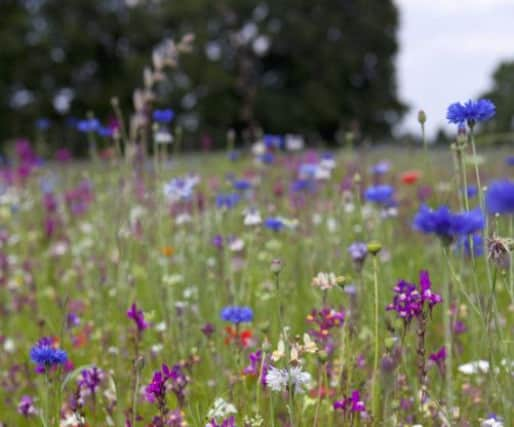Go wild for flowers


WILDFLOWERS are back in fashion, according to reports on their sales.
In the past year, sales of UK wildflower seeds have increased by 60 per cent, thanks partly to renewed interest fuelled by the stunning wildflower meadows at the Olympic Park in 2012.
Advertisement
Hide AdAdvertisement
Hide AdThe combined elements of eye-catching visual impact, ecological awareness and wildlife value have fuelled sales of wildflower seeds among many of the main seed companies, including Thompson & Morgan, Suttons and Mr Fothergill’s.
With this in mind, the Royal Horticultural Society (RHS) is playing its part during National Gardening Week (April 15-21) as its gardens across the country host talks, demonstrations and events to get gardeners growing wildflowers.
Young gardeners will be encouraged to get their hands dirty and learn how to sow their own mini-wildflower meadow, perfect for attracting birds, bugs and creepy crawlies of all types.
More experienced gardeners can find out how to support the wildlife in their gardens through a range of talks and interactive workshops on beekeeping, managing meadows and more.
Advertisement
Hide AdAdvertisement
Hide AdIan LeGros, curator at RHS Garden Hyde Hall in Essex, explains: “Wildflowers are currently going through a massive boom in popularity and are set to be one of the big trends for amateur gardening in 2013.
“They are easy to plant and maintain, provide much needed habitats for wildlife and are valuable sources of nectar and pollen for bees and other pollinators.
“Encouraging wildlife and pollinators is particularly important in urban areas, so if you’ve a sunny patch of dry ground that won’t support much else in your front garden, it’s time to convert it into a wildflower meadow.”
He offers the following tips to those who want to follow the wildflower fashion:
Advertisement
Hide AdAdvertisement
Hide Ad:: Choose seed carefully. Wildflowers are easy to grow but, like all plants, need the right conditions if they are going to thrive. Check your soil type and find a mix that will work for it.
:: Poor soil? Look to perennials. If you have poor soil perennial wildflowers will do very well as there will be fewer grasses for them to compete with. Buy seed mixes that contain ox-eye daisies, yarrow, harebells, birdsfoot trefoil, cowslips, lady’s bedstraw, betony, yellow rattle and others for waving drifts of colour.
:: Go mad with colour. If you have well-cultivated soil, annuals such as cornflowers, corn poppies, corn marigolds and corncockles will do well. Toss in a few barley and wheat seeds for an authentic feel. Annuals are a good choice if you are converting an existing border.
:: Time of sowing a meadow is important. An annual seed mix containing cornflowers and poppies will do better if sown in the autumn, while corn marigolds prefer a spring sowing. If you have sandy or well-drained soils, wildflowers can be sown during the autumn, but if you have wetter, colder soils, you’re better off sowing in the spring to avoid seed rotting off.
Advertisement
Hide AdAdvertisement
Hide Ad:: Prepare your ground. Wildflowers are easy but do take a bit more work than just opening a packet of seeds over the ground. Prepare your soil first, making sure it is weed free and has been well dug or rotovated. If you are growing wildflowers, keep fertility low in most cases, so avoid using manures or fertilisers as this will just give grasses and weeds the advantage they need to crowd out your wildflowers.
:: For full details of the events at RHS Gardens during National Gardening Week, visit www.nationalgardeningweek.org.uk
BEST OF THE BUNCH - Lily of the Valley (Convallaria majalis)
They may seem a fairly insignificant sight in a border but their fragrance is unparalleled, wafting through the air on a warm spring day.
Advertisement
Hide AdAdvertisement
Hide AdI have them in drifts in a shady spot around a garden seat, to enable visitors to experience the sweet scent first hand.
You can also cut the stems of the small, neat, white bell-shaped flowers to put in a small vase and bring inside.
Planted singly, they only span 10cm x 5cm (4in x 2in) but they soon spread sideways to make a loose carpet, and be careful if you’re planting them in a border among other plants because they can become invasive.
They prefer rich, fertile soil with lots of added organic matter, in a shady spot. They are great ground cover plants for shady, damp situations, spreading by means of creeping roots.
Advertisement
Hide AdAdvertisement
Hide AdOther varieties include ‘Albostriata’, which has gold striped leaves, and ‘Fortin’s Giant’, a slightly taller type, growing to a height of 30cm (12in).
WHAT TO DO THIS WEEK
:: Sow and plant out vegetables including beetroot, broad beans, carrots, celeriac, kohlrabi, onions, peas, spinach, swedes and turnips.
:: Sow seeds of tomatoes in a heated propagator or on a warm windowsill to grow on outdoors when all danger of frost is over.
:: Deadhead daffodils as they fade.
:: Apply a spring fertiliser to established lawns once they are actively growing and cut grass when it is about 8cm (3in) high.
:: Don’t let pots and seed trays in the greenhouse dry out.
:: Prune young tree heathers.
:: Clip ivy growing on walls to tidy it up.
Advertisement
Hide AdAdvertisement
Hide Ad:: Clear crops of leeks and celery which are still remaining, so that the ground can be prepared for new crops.
:: Sow a few sunflower seeds under glass to encourage the children to become interested in gardening.
:: Prune dogwoods and shrubby willows grown for their ornamental stems.
:: Get rid of seedheads and stems to make way for new growth, and dress the soil with a fertiliser so it is ready for a layer of mulch.